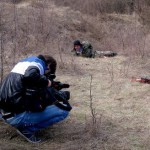4th April 2012
UK-Ukraine leadership training in Crimea
Guest blog by Major Kirsty Baxter, Assistant Military Attaché Kyiv

There is an explosion; then we hear the screams for help. Quickly we turn and jog back down the path. Our group of military attachés and Ukrainian officers find a badly injured sergeant, his foot blown off by a mine booby-trap. As he begs for help and calls out for his mother, we see sergeants standing guard and another prodding the ground to clear a path to the injured man through more potentially explosive devices.
Thankfully the sergeant is not injured (though we all agree that he should have won an Oscar for his acting skills and his instructor for the special effect of the severed foot). This is an exercise at the Staryi Krym training area outside Feodosia, involving 45 sergeants from the Ukrainian Naval Infantry Battalion and other units in the Coastal Defence Forces.
The sergeants have just completed a three-week course delivered by instructors from the British Military Advisory Training Team (BMATT). Attachés, senior Ukrainian officers and journalists have gathered for a Distinguished Visitors’ Day to view the culmination of the training. The course has been designed to further develop the sergeants’ command and leadership skills whilst practising tactics and techniques needed to participate in international peace support operations. It’s part of a wide-ranging and productive programme of UK-Ukraine military co-operation.
A team from the BMATT has visited Feodosia before. Six instructors came a year ago, developing tactics and techniques to help the 1st Company of the Naval Infantry Battalion pass an evaluation to be more interoperable with western forces during peacekeeping and humanitarian operations. The 1st Company’s newly-acquired skills saw them pass the evaluation at a high standard during the multinational Exercise SEA BREEZE 2011 later that year. The unit was the Ukrainian land component to the Greek-led HELBROC EU Battlegroup for 6 months from 1 July 2011.
The guiding principle of the BMATT is ‘advise, never dictate’. We saw this clearly in Staryi Krym. The scenarios on the Distinguished Visitors’ Day were designed by the Naval Infantry instructors following the training, with only background support provided by the BMATT instructors, and carried out by the sergeants on the course. The “injured” sergeant was part of a training scenario where the sergeants showed their marines how to detect and avoid mines and booby traps as well as safe casualty evacuation. The visitors also saw a demonstration on tackling a suicide bomber as well as how to clear a wooded area of insurgents.
The attachés were impressed by what they saw. Capt Fin Farthing, the Royal Marine officer leading the BMATT team, said that it had been a pleasure to work again with ‘such clearly motivated, professional soldiers’. The 1st Company of the Naval Infantry Battalion is now looking forward to another evaluation during Ex SEA BREEZE 2012 and the other companies in the Battalion are making use of the 1st Company’s skills to train their marines to the same standard.
Photo report from the military exercise
Read the book called Bloodlands: Europe Between Hitler and Stalin. I live in Canada and had no cocnpet of the level of devastation that struck Ukraine, Poland, Belarus and the Baltic States. 14 million, non-combatants, were murdered by political decree between 1933 and 1945. They all suffered horribly but Ukraine worst of all. These people still feel those wounds, it happened only a generation ago.